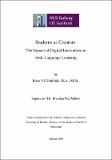| dc.description.abstract | The overall aim of this study is to explore the possibilities for enhancing the Irish-language learning experience in English-medium primary school classrooms through students collaboratively constructing digital artefacts via design-based learning activities. Specifically, the researcher investigates the potential of digital storytelling and animation tools to enhance students’ attitudes towards and abilities in the Irish language. This study culminates in a practical innovative model called TALES (Technology, Activity, Language Learning, Engagement and Story). It supports a student-centred, technology-enhanced, design-based, constructionist and collaborative approach to language learning. It can be adopted and adapted by Irish-language teachers to foster a more active, communicative and creative approach to language learning.
TALES engaged students in innovative Irish-language learning activities. Curriculum was upheld through students writing stories around curricular themes and drawing on specific language constructs in the process. Technology learning was supported through students engaging in meaningful design activities using constructionist tools as they created digital and animated stories. TALES integrates all four language skills through the storytelling phase and then maps them to four corresponding multimedia skills during the digital recreation phase, developing language and technology skills in the process. TALES externalises student thinking whilst they collaboratively create sharable learning artefacts, negotiating meaning and deepening learning in the process. It engages students in the meaningful production of the Irish language, providing them with increased and spontaneous opportunities to speak and write the language through creative writing and digital recreation activities, and all through the medium of Irish.
TALES not only offers a possible solution to the problem of underachievement in Irish in English-medium schools, but it is also a powerful and inspiring example of how Irish can be taught and learned in a meaningful fun way. Students were intrinsically motivated to learn. They showed a greater interest in Irish and demonstrated a more positive attitude towards the language. Their comprehension and written skills improved. While their oral skills also improved and students made more of an attempt to speak in Irish, it was at a slower rate. They also became more digitally fluent as they became more adept at designing and creating, and they developed interpersonal, communicative and problem-solving skills in the process. | en_IE |


